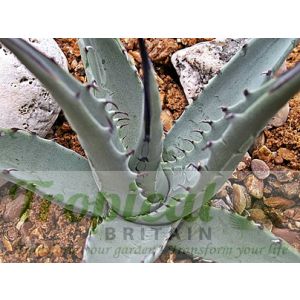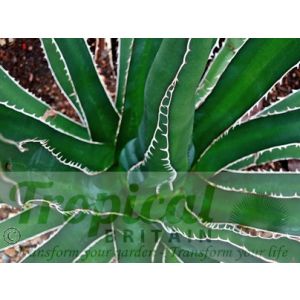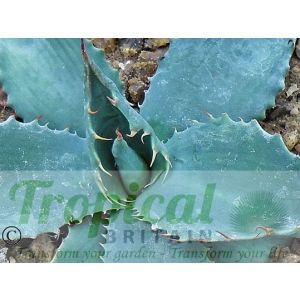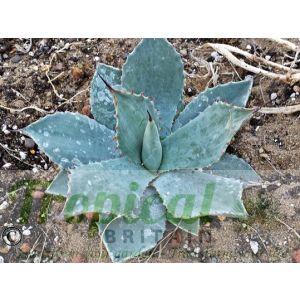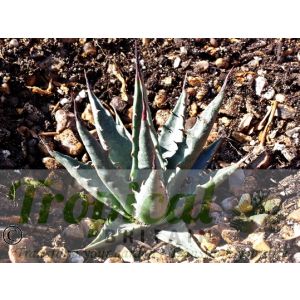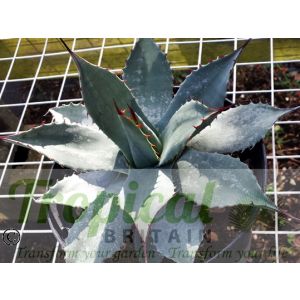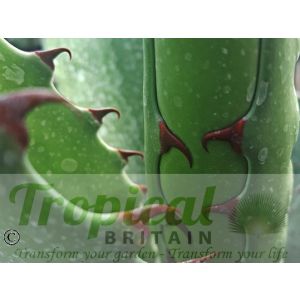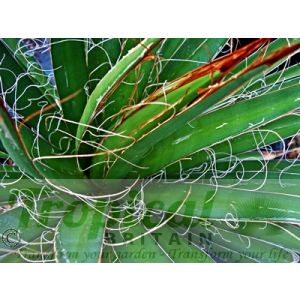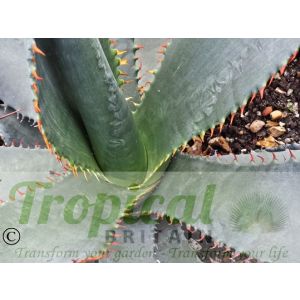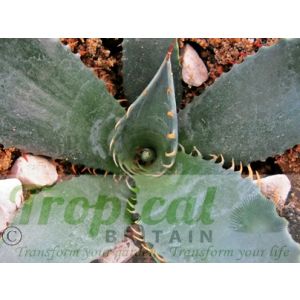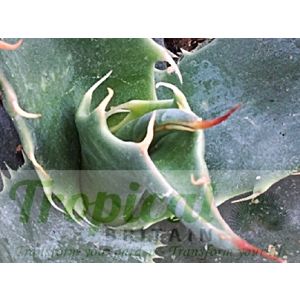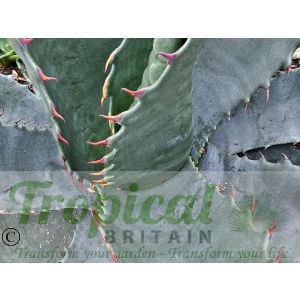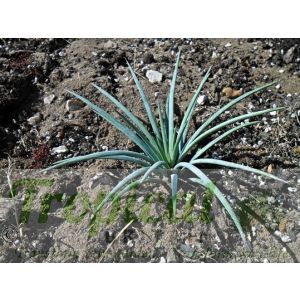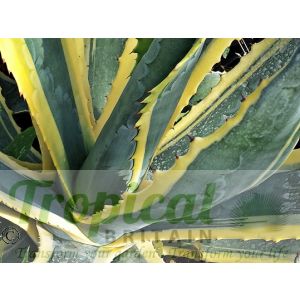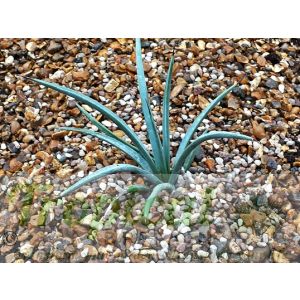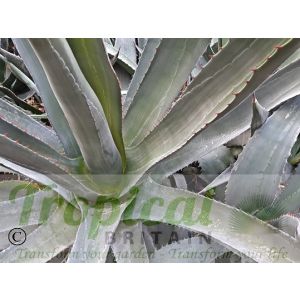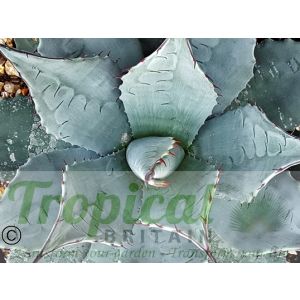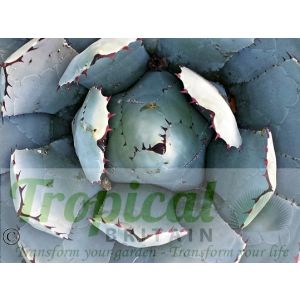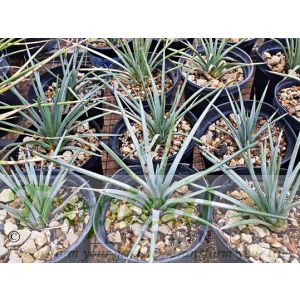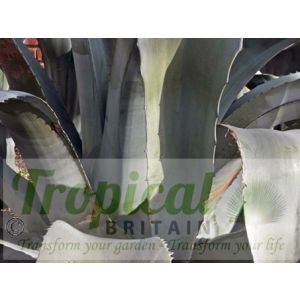- Spiky pincushion
- Forming clustering colonies with age
- Very sculptural form
- Perfect drainage required
Agave stricta, the Hedgehog Agave, is endemic to the Tehuacan Valley in northern Puebla and southern Oaxaca where it grows at elevations of 1700-1850 metres on arid calcareous soils. It forms offsets as it grows, creating dense distinctive colonies of pincushion growth. This tight spiky growth consists of elongated thin usually upcurved and very rigid leaves with a greyish-black terminal thorn.
It is cold tolerant to around -5C if kept completely dry and can withstand fluctuations dipping below that for short periods of time. Despite its fierce spiky nature it has enormous architectural appeal and can be used within the microclimate of urban London in areas that have no human footfall. In drier parts of southern England it can also be experimented with outdoors but - as with all Agaves - attention needs to be paid to ensure a free-draining substrate and - in this instance - a rainshelter for the winter. In its native habitat it is often found growing on rocky slopes so planting on a gradient or in a raised bed is sensible.
Similar in both form and name to Agave striata...
In early spring, after the stress of the winter and as the light levels suddenly increase in clear sunny days in March, Agave stricta often takes on a distinctive reddish colouration. This tends to grow out during the course of the summer and return to green but it is not especially uncommon for it persist throughout the summer. Red colouration in succulents is very common and usually associated with any number of stress factors. There has been some debate about its 'Rubra' nature and whether it is a genuinely distinctive form. We grow thousands of Agave stricta 'Rubra' every year. We also grow the 'ordinary' Agave stricta. Are they different? Not really. Both have a tendency to turn red. But not all of them. Some do ... and some don't ... in both populations ... in exactly the same conditions. It is normal for large populations both in the wild and in cultivation to show some variation even when experiencing exactly the same climatic and environmental conditions. That doesn't make it a distinct describable taxonomic form or variety. It is probably more appropriate to think of Rubra as a state rather than a separate form. Plants raised from seed which has been collected from selected red specimens (as these have been) may show more inclination to turn red. Maybe. If we begin to notice a statistically significant proportion of one population that has more red examples during the spring and summertime flush we will let you know...
In the meantime - red or green - they are rather gorgeous; dangerously so...
These are larger plants in 3 Litre pots.
Additional Information
| Order | Asparagales |
|---|---|
| Family | Asparagaceae |
| Sub-Family | Agavoideae |
| Synonyms | Agave striata f. stricta, Agave striata subsp. stricta, Agave striata ssp. stricta, Agave striata var. stricta, Bonapartea stricta |
| Geographical Origin | Mexico: the Tehuacan Valley in northern Puebla and southern Oaxaca |
| Cultivation | Full sun. Perfect drainage. Alkaline substrate. Plant on a gradient or raised bed if outdoors. Keep absolutely dry from October until March |
| Eventual Height | 70cm |
| Eventual Spread | Spreading to 2-3 metres when mature |
| Hardiness | Not fully hardy. Down to about -5C. Keep it fleeced in colder weather and keep it dry |
1 Item
-
Good plants & service !Price100%Value100%Quality100%5 nice agaves that arrived happy & healthy even-though the courier had damaged the box. Testament of good packaging!!
Also good communication via phone & emails from John & Marilyn! nice to finally be able to reach “humans” & especially ones that know what they are talking about!
Shame we are nowhere near the nursery to be able to visit & get large specimens!Review by Froggy
Posted on
1 Item

Free DELIVERY
ON ALL ORDERS OVER £99THIS OFFER IS VALID ON ALL OUR STORE ITEMS.
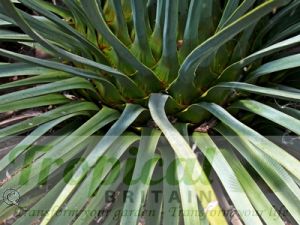
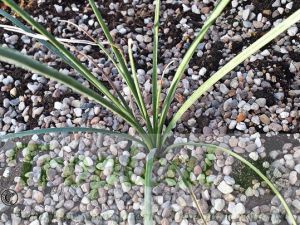
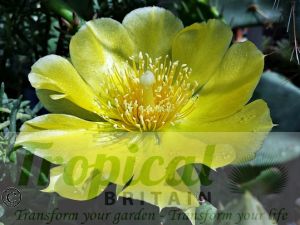
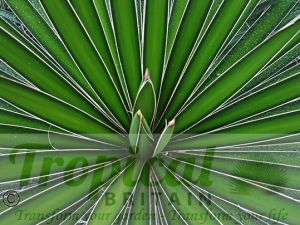
THE PLANTS
- Smaller-Growing Succulents
- Aeonium
- Agave
- Agave americana
- Agave amica
- Agave chrysantha
- Agave cupreata
- Agave deserti
- Agave filifera
- Agave gentryi
- Agave gomezpompae
- Agave havardiana
- Agave horrida ssp horrida
- Agave lechuguilla
- Agave mitis var mitis
- Agave montana
- Agave palmeri
- Agave parryi
- Agave polianthiflora
- Agave striata
- Agave stricta Rubra
- Agave toumeyana
- Agave univittata
- Agave utahensis
- Agave victoriae-reginae - Huasteca Canyon
- Aloe
- Beschorneria
- Bryophyllum
- Dasylirion
- Furcraea
- Hesperaloe
- Hesperoyucca
- Nolina
- Yucca
- Astrophytum
- Austrocylindropuntia
- Brasiliopuntia brasiliensis
- Cereus
- Chamaecereus silvestrii
- Cleistocactus
- Cumulopuntia
- Cylindropuntia
- Echinocereus
- Echinopsis
- Epiphyllum
- Ferocactus
- Gymnocalycium
- Hatiora
- Kroenleinia grusonii
- Lophocereus
- Maihuenia
- Mammillaria
- Matucana
- Myrtillocactus geometrizans
- Opuntia
- Opuntia arenaria SB964
- Opuntia atrispina
- Opuntia basilaris
- Opuntia chisosensis SB992 Brewster Co, TX
- Opuntia cymochila - Brewster Co, TX
- Opuntia engelmannii var. sandia
- Opuntia erinacea
- Opuntia fragilis
- Opuntia humifusa
- Opuntia lindheimeri - Beeville, TX
- Opuntia phaeacantha
- Opuntia pottsii var. nova DJF1441 SW Albuquerque, NM
- Opuntia robusta
- Opuntia sandiana
- Opuntia sanguinicola
- Opuntia stricta
- Opuntia strigil
- Opuntia trichophora
- Oroya peruviana
- Parodia
- Polaskia
- Rhipsalis
- Schlumbergera
- Stenocactus
- Stetsonia
- Tephrocactus
- Alocasia
- Amorphophallus
- Arisaema
- Arum
- Calla
- Caladium
- Colocasia
- Dracunculus
- Monstera
- Helicodiceros muscivorus
- Philodendron
- Pinellia
- Remusatia
- Sauromatum
- Spathantheum
- Typhonium
- Xanthosoma
- Zantedeschia










